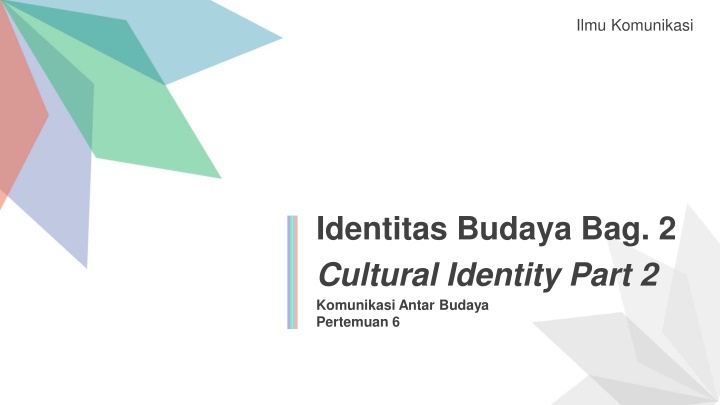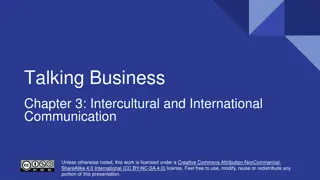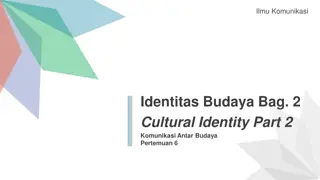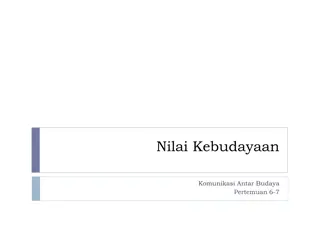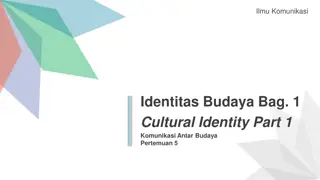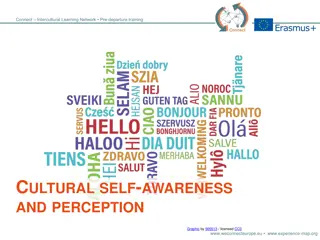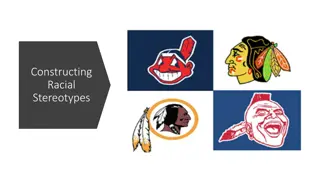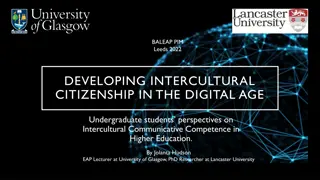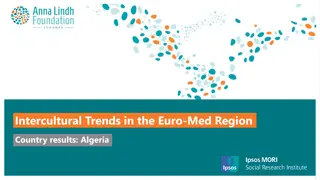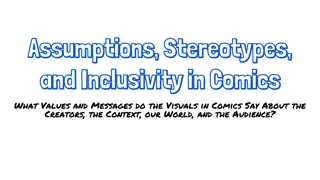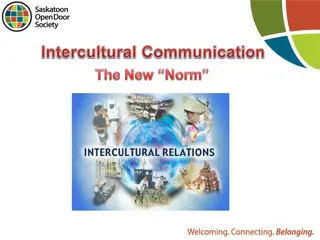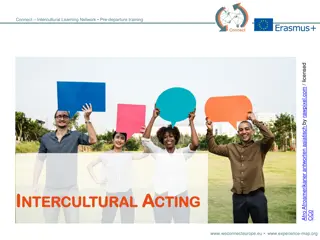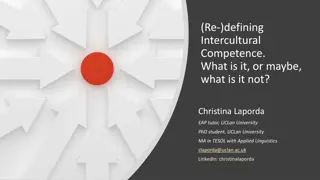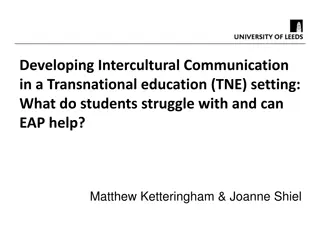The Impact of Stereotypes on Intercultural Communication
Stereotyping is a complex form of categorization that simplifies perceptions into broad categories, affecting how we interact with different cultural groups. Stereotypes are learned through socialization processes, media influence, and other factors, leading to filters that hinder effective communication. These oversimplified generalizations can hinder intercultural communication by distorting reality, creating false assumptions, and promoting resistance to change.
Download Presentation

Please find below an Image/Link to download the presentation.
The content on the website is provided AS IS for your information and personal use only. It may not be sold, licensed, or shared on other websites without obtaining consent from the author.If you encounter any issues during the download, it is possible that the publisher has removed the file from their server.
You are allowed to download the files provided on this website for personal or commercial use, subject to the condition that they are used lawfully. All files are the property of their respective owners.
The content on the website is provided AS IS for your information and personal use only. It may not be sold, licensed, or shared on other websites without obtaining consent from the author.
E N D
Presentation Transcript
Ilmu Komunikasi Identitas Budaya Bag. 2 Cultural Identity Part 2 Komunikasi Antar Budaya Pertemuan 6
The Dark Side of Identity Stereotyping Stereotyping is a complex form of categorization that mentally organizes your experiences with, and guides your behavior toward, a particular group of people. It becomes a means of organizing your perceptions into simplified categories that can be used to represent an entire collection of things or people. The reason for the pervasive nature of stereotypes is that human beings have a psychological need to categorize and classify. The world is too big, too complex, and too dynamic to comprehend in all its detail. Hence, you tend to classify and pigeonhole. Stereotypes can be positive or negative. Those that refer to a large group of people as lazy, coarse, vicious, or moronic are obviously negative. There are, of course, positive stereotypes, such as the assumption that all Asian students are hardworking, well mannered, and intelligent. Samovar et all. 2010. Communication Between Cultures Hal. 202 Versi Bahasa Indonesia
LEARNING STEREOTYPES When do we learn stereotypes? Remember, you are not born with stereotypes; they are learned, and like culture, they are learned in a variety of ways. The most obvious, and perhaps most important, agent of stereotypes is the socialization process, which begins with our parents. While many parents try to avoid teaching their children to think in stereotypes, we tend to agree with Schneider when he notes that often parents directly or indirectly actually promote them. Many stereotypes are generated by the mass media and widely disseminated through a variety of formats such as advertisements, movies, and TV sitcoms, soap operas, and reality shows. Television has been guilty of providing distorted images of many ethnic groups, the elderly, and gay people. Media has also played a role in perpetuating certain stereotyped perceptions of women and men. Samovar et all. 2010. Communication Between Cultures Hal. 203 Versi Bahasa Indonesia
why stereotypes hamper intercultural communication? First, stereotypes are a kind of filter; they only allow in information that is consistent with information already held by the individual. In this way, what might be the truth can be filtered out. For example, women were stereotyped for many years as a rather one-dimensional group confined to the role of homemaker. That stereotype often kept women from advancing in the workplace. Second, it is not the act of classifying that creates intercultural problems. Rather, it is the assumption that culture-specific information applies to every member of a particular cultural group. Stereotypes conjecture that all members of a group have exactly the same traits. Third, stereotypes also keep you from being a successful communicator because they are oversimplified, exaggerated, and overgeneralized. Stereotypes distort because they are based on half-truths and often- untrue premises and assumptions. Guirdham reaffirms this important point when he notes that stereotypes alter intergroup communication because they lead people to base their preparation, transmission, and reception of messages on false assumptions. Fourth, stereotypes are resistant to change. Samovar et all. 2010. Communication Between Cultures Hal. 205 Versi Bahasa Indonesia
How to avoid stereotypes? Let s discuss it on your Collabor Forum!
The Dark Side of Identity Prejudice Prejudice generalization about a group of people or things, often based on little or no factual experience. Prejudice can be positive (liking a certain group or thing) or negative (disliking a certain group or thing). occurs when a person holds a The Functions of Prejudice (1) The ego-defensive function allows individuals to hold a prejudice while denying to themselves that they possess negative beliefs about a group. (2) The utilitarian function permits people to believe that their prejudicial beliefs produce a positive outcome. This is often found in situations where economic gain is involved. In Ruscher, the negative feelings and attitudes held by those who hold a prejudicial perspective are often exhibited through the use of group labels, hostile humor, or speech that alleges the superiority of one group over another. a communication setting, according to (3) The value-expressive function occurs when people maintain their prejudice in the belief that their attitudes represent the highest and most moral values of the culture. (4) The categorize, organize, and construct their perceptions of other people in a manner they see as rational even if that perception is woefully inaccurate. Samovar et all. 2010. Communication Between Cultures Hal. 207 Versi Bahasa Indonesia knowledge function enables people to
EXPRESSIONS OF PREJUDICE First, prejudice can be expressed through what Allport refers to as antilocution, which involves talking about a member of the target group in negative and stereotypical terms. The fourth level of prejudice involves physical attacks, which often escalate in hostility and intensity if left unchecked. The fifth, and most alarming, form of prejudice is extermination. This expression of prejudice leads to acts of physical violence with the objective of removing or eliminating all or major segments of the target group community. Second, people act out prejudice through avoidance. This occurs when people avoid and/or withdraw from contact with the disliked group. Third, when discrimination is the expression of prejudice, the prejudiced person will attempt to exclude all members of the group in question from access to certain types of employment, residential housing, political rights, educational and recreational opportunities, churches, hospitals, or other social institutions. Samovar et all. 2010. Communication Between Cultures Hal. 208 Versi Bahasa Indonesia
CAUSES OF PREJUDICE (1) Societal sources: A great deal of prejudice is built into the major organizations and institutions of a society. According to Oskamp, these organizations produce norms, rules, regulations, and laws that give rise to societal prejudice and help maintain the power of the dominant groups over subordinate ones. (2) Maintaining social identity: At the beginning of this chapter we pointed out the important role that identity plays in connecting people to their culture. This link is very personal and emotional because it creates the bond that binds people and culture together. (3) Scapegoating: Scapegoating occurs when a particular group of people, usually a minority, is singled out to bear the blame for certain events or circumstances, such as hardships, that adversely affect the dominant group. economic or social Samovar et all. 2010. Communication Between Cultures Hal. 210 Versi Bahasa Indonesia
How to avoid prejudice? Let s discuss it on Collabor Forum!
The Dark Side of Identity Racism Racism is the belief in the inherent superiority of a particular race. It denies the basic equality of humankind and correlates ability with physical composition. Thus, it assumes that success or failure endeavor will depend endowment rather than access to opportunity. ~ Leone in any societal genetic upon environment and The idea of superiority allows one group of people to mistreat another group on the basis of race, color, national religion, or sexual preference. origin, ancestry, Samovar et all. 2010. Communication Between Cultures Hal. 211 Versi Bahasa Indonesia
EXPRESSIONS OF RACISM Personal racism consists of racist acts, beliefs, attitudes, and behaviors on the part of the individual persons. Referring to institutional racism, Bloom is very specific when he writes, Institutional racism refers to racial inferiorizing or antipathy perpetrated by specific social institutions such as schools, corporations, hospitals, or the criminal justice system as a totality. Samovar et all. 2010. Communication Between Cultures Hal. 212 Versi Bahasa Indonesia
AVOIDING RACISM First, try to be honest with yourself when deciding if you hold any racist views. It is a simple point to state, but a difficult one to accomplish. Yet, confronting personal racist views is an important first step. Second, object to racist jokes and insults whenever you hear them. This daring and sometimes courageous message to other people that you denounce racism in whatever form it may take. act will send a Third, as straightforward as it sounds, respect freedom. Fourth, examine the historical roots of racism. Samovar et all. 2010. Communication Between Cultures Hal. 213 Versi Bahasa Indonesia
The Dark Side of Identity Ethnocentrism Ethnocentrism is the notion that one s own culture is superior to any other. It is the idea that other cultures should be measured by the degree to which they live up to our cultural standards. We are ethnocentric when we view other cultures through the narrow lens of our own culture or social position. ~ Nanda and Warms. Samovar et all. 2010. Communication Between Cultures Hal. 214 Versi Bahasa Indonesia
CHARACTERISTICS OF ETHNOCENTRISM Ethnocentrism Contributes to Cultural Identity Another reason ethnocentrism pervasive is that it provides members of a culture with feelings belonging. Levels of Ethnocentrism positive, negative, and extremely negative. is so of identity and Ethnocentrism Is Universal Most people are ethnocentric, and a certain degree of probably is essential if people are to be content with their lives and if their culture is to persist. ethnocentrism Ethnocentrism is strongest in moral and religious contexts, where emotionalism may overshadow rationality and cause the type of hostility. Samovar et all. 2010. Communication Between Cultures Hal. 215 Versi Bahasa Indonesia
AVOIDING ETHNOCENTRISM First, try to avoid dogmatism. Second, learn to be open to new views. Samovar et all. 2010. Communication Between Cultures Hal. 216 Versi Bahasa Indonesia
